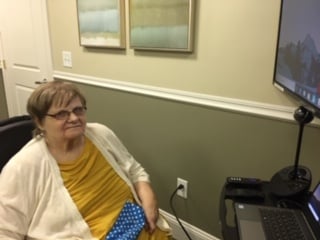Prioritizing health: Telehealth initiatives at Walker Methodist
Amy Weiss | Jun 16, 2020

Janice, a resident at Walker Methodist Care Suites in Edina, received a special Zoom call recently. She was looking forward to her call for days before and said how much she enjoyed it after the meeting. Who was Janice excited to see? Her doctor. Janice benefits from virtual check-ins and follow-ups with her provider, thanks to Walker Methodist’s new telehealth program. After her visit, Janice said, “It’s a great solution. She talks to me, and I know I’m safe.”
Because Walker Methodist is following procedures and policies from the Centers for Disease Control (CDC) and Minnesota Department of Health (MDH), visitors are no longer able to visit communities. This safety precaution also extends to providers, so we wanted to ensure residents can still connect with doctors and other care providers. To meet this need and offer the best experience possible, our teams worked quickly and efficiently to provide a solution.
Christian Gustafson, chief technology officer at slashBlue, is working with Walker Methodist’s teams, including information technology (IT) and maintenance. With the expertise of Christine Kelley, director of clinical programming, the team developed this new, effective tool called collaboration carts.
“We were already working on this project, but we accelerated development so residents can connect with doctors and providers during our current circumstances,” said Christian.
Collaboration carts are made of a large TV with a camera, a microphone, and laptop connectivity. Currently, each Walker Methodist community has at least one cart, and Christine is working to train team members on how to use them.
She developed two roles to help implement carts at each community. First, telehealth advocates (usually resident service managers or social workers) act as point people. Advocates are trained how to use carts, schedule telehealth meetings, and work with providers. Facilitators are trained by advocates. These team members bring residents to meeting spaces with carts or bring carts to residents. Facilitators also stay with residents during appointments and sanitize before and after telehealth meetings. “Our leaders are completely on board and excited about this initiative,” said Christine.
Walker Methodist teams use Zoom’s HIPAA-compliant option for meetings and telehealth visits. The team worked with providers to make sure they were compliant and comfortable using this technology. Collaboration carts can also be used for other meetings, trainings, and more. As bringing new team members to Minneapolis for orientation gets more challenging, collaboration carts brings new potential to this training. Employees can meet in conference rooms at their communities and zoom into meetings or training sessions. In the future, Christine hopes carts can be used for care conferences, enabling family members living far away to call in. “There’s potential here, and we’ve already started to use it,” said Christine. “I’m excited to see how this project will continue to grow.”
Collaboration carts and the telehealth initiative display Walker Methodist’s values of respect, collaboration, and imagination. In uncertain times, this project meets residents needs while relieving stress and bringing comfort. “Seeing your doctor on a 65-inch display makes it feel like the person you already know is in the room with you,” said Christian. “The level of trust and interaction is already there. Residents still thrive from connection.”
Telehealth meetings have been well-received at Walker Methodist communities by team members and residents alike. “We’ve heard from many residents, and they’re grateful to see their physicians and get the care they need without having to go outside,” said Christine. “The primary response we’ve been hearing is gratitude.”
